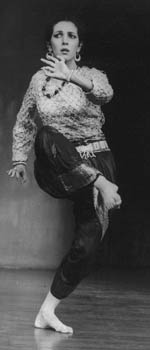
An innovative choreography that blends the Mayurbhanji Chhau technique, a semi-classical style from the east Indian state of Orissa with the famous classic Greek myth.
The Greek myth goes that Echo, seeing the beautiful Narcissus hunting in the forest, falls in love with him. At first entices and then rejected by him, out of despair, she loses her body and remains only a voice that cannot be silent if others talk, but cannot talk if others remain silent. Narcissus, proud and unapproachable, and cursed by all the nymphs to fall in love with somebody he can never get, falls in love with his own reflection in the water. This insane attachment to his own reflection leads him to a premature death.
Visually, Narcissus has been rendered as movement and Echo as vibration created by the movements. By trying to escape from his own projections, Narcissus instead, gets more and more trapped by them. His incapacity to relate to others and his introverted obstinacy lead him towards a final dissolution into the water of the unconscious.
CREDITS
Date of production - April 1985
Choreography - Ileana Citaristi
Music - Igor Watkevitch
Duration - 18 min
Some press comments:
“Set to the musical contribution by Auroville’s great gift to music, composer Igor Watkevich, her choreography shone with the iridescence of a gem, the depth imparted by severe practice and above all an intellectual approach to the possibilities of the style. How balletic, how superbly modern, how expressive were the ways in which she used the traditional Chhau ‘topka’ and ‘upli’.”
New Delhi, The Hindustan Times, August 25, 1986
“With her svelte figure and complete command over the idiom she succeeded in translating the images in an effortless manner. This inter-relationship between the electronic music, the Mayurbhanji Chhau technique and exquisite lighting which played an important role in this choreographic piece, put the number in a class by itself.”
Calcutta, The Statesman, March 11, 1986